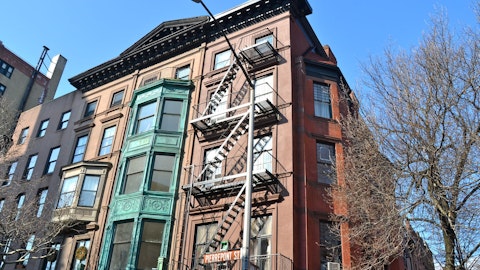Ares Commercial Real Estate Corporation (NYSE:ACRE) Q4 2022 Earnings Call Transcript February 15, 2023
John Stilmar: Good afternoon, and thank you for joining us on today’s conference call. I’m joined by our CEO, Bryan Donohoe; and our CFO, Tae-Sik Yoon. In addition to our press release and the 10-K that we filed with the SEC, we have posted an earnings presentation under the Investor Resources section of our website at www.arescre.com. Before we begin, I’ll remind everyone that comments made during the course of this conference call and webcast as well as the accompanying documents contain forward-looking statements and are subject to risks and uncertainties. Many of these forward-looking statements can be identified by the use of words such as anticipates, believes, expects, intends, will, should, may and similar such expressions.
These forward-looking statements are based on management’s current expectations of market conditions and management’s judgment. These statements are not guarantees of future performance, condition or results and involve a number of risks and uncertainties. The company’s actual results could differ materially from those expressed in the forward-looking statements as a result of a number of factors, including those listed in its SEC filings. Ares Commercial Real Estate Corporation assumes no obligation to update any such forward-looking statements. During this conference call, we will refer to non-GAAP financial measures. We use these measures of operating performance, and these measures should not be considered in isolation from or as a substitute for measures prepared in accordance with Generally Accepted Accounting Principles.
These measures may not be comparable to like-titled measures used by other companies. Now, I’d like to turn the call over to our CEO, Bryan Donohoe.
Bryan Donohoe: Thanks, John and good afternoon, everybody. This morning we reported fourth quarter results, which included the second highest level of quarterly distributable earnings in our history of $0.44 per share and capped off a strong year, where our annual distributable earnings of $1.55 per share matched our previous record in 2021. Throughout 2022, the overall strength in our distributable earnings was driven primarily by the continued benefits of our nearly 100% floating rate interest rate sensitive asset base. In addition, we hedged or fixed approximately one-third of our liabilities. 2022 was a very successful year in which we fully covered our regular and supplemental dividends from distributable earnings at 110%.
In addition, we made a conscious decision to bolster our liquidity and further strengthen our balance sheet throughout much of the year. While our strong distributable earnings benefited from the tailwind of higher interest rates, the same higher interest rates have also led to some headwinds for the overall commercial real estate market. Specifically, we’re seeing many property owners take a pause on executing business plans as they adjust to these historic increases in market interest rates. At the same time, certain markets are experiencing weaker leasing and occupancy trends. As has been well publicized office market in particular is facing challenges from shifting demand in a post-pandemic economy. Although, we believe our senior loan oriented portfolio has been carefully constructed, we aren’t immune to the effects that these market headwinds present.
As you’ll hear from Tae-Sik, these industry-wide movements have resulted in higher credit reserves, a greater number of loans in default are on non-accrual status and elevated risk ratings. We are very focused on maximizing the outcomes for these situations and we believe we are well equipped to handle them. It’s important in the context of the broader industry headwinds to take a minute to review our positioning and capabilities. At Ares, we believe we have a demonstrated playbook on navigating volatile markets and capitalizing on illiquid environments. Our approach during these periods is first and foremost to operate with additional liquidity while keeping an eye towards opportunistic investments. The Ares Real Estate Group has over $51 billion of assets under management and more than 2,000 properties globally managed by over 240 investment professionals.

Photo by floriane vita on Unsplash
This provides significant advantages to ACRE in helping understand markets and then tapping into extensive asset level experience. These insights led us to shift into a more defensive posture in 2022 and puts us in a better position to navigate a more complex real estate market going forward. Our overall liquidity was enhanced by $823 million in principal loan repayments during 2022, a new record for our company. In addition to these loan repayments, we realized more than $38 million of proceeds from the sale of the Westchester Marriott in the first quarter of 2022. This was a property where we became the owner in 2019, successfully navigated operationally through COVID and executed the business plan for the property. This led to a positive return through the total life of the investment and highlights one of the many ways we can achieve successful outcomes with the property operating below plan.
In terms of our investment activity during 2022, we originated $725 million of new loan commitments with more than one-third exceptional commitment in the multifamily sector. Additionally, we invested opportunistically in AAA securities backed by a diverse pool of underlying loans. Looking forward, there is significant uncertainty regarding the commercial real estate market and property values. Our focus will be to resolve certain situations to maximize outcomes, while prudently deploying capital into attractive new investment opportunities. We believe our liquidity and property-level expertise position us well to successfully navigate and ultimately capitalize on the current environment. With that let me now turn the call over to Tae-Sik to walk through some of our financial highlights and further details on our portfolio and capital position.
Tae-Sik Yoon: Great. Thank you, Bryan, and good afternoon, everyone. For the fourth quarter of 2022, we reported GAAP net income of $2.9 million or $0.05 per common share and distributable earnings of $23.9 million or $0.44 per common share. For full year 2022, GAAP net income was $29.8 million or $0.57 per common share and distributable earnings were $80.7 million or $1.55 per common share. For full year 2022, similar to 2021, we more than fully covered our dividends through distributable earnings at 110%, as we continued to build on our long-term track record of having distributable earnings per share in excess of both the regular and supplemental dividends. Most notably, we have delivered a consistent and growing dividend throughout the life of our company with no history of dividend reductions or delays.
Turning to our asset base, we ended the quarter with a loan portfolio consisting of 98% senior loans and an outstanding principal balance of $2.3 billion diversified across 60 loans. During the fourth quarter, we collected 99% of our contractual interest rate. In terms of our other credit quality metrics, 80% of our loan portfolio had a risk rating of three or better, which declined from 90% in the third quarter of 2022. This change primarily reflects the negative migration of one office property loan and one mixed-used proper loan, which were downgraded from three to four due to our outlook on their respective business plans and our macroeconomic view of their respective submarkets. As it relates to CECL, we increased our total reserve by $19.4 million during the fourth quarter of 2022 and our total CECL reserve stands at $71.3 million or about 3% of our total loan commitments at year-end 2022.
Shifting to post quarter end activity in January 2023, we successfully resolved a senior loan backed by a residential property located in California. Through our structuring capabilities and the experience of our asset management team, we were able to recover approximately 98% of our cumulative cash investment in this loan. On a GAAP basis, we expect to take a $5.6 million realized loss in the first quarter of 2023. However, as we held a specific reserve on this loan as of year-end 2022 in the same amount, we do not expect any material net GAAP loss in the first quarter of 2023 in connection with the resolution of this loan. This loan was our only risk-weighted five asset at year-end 2022. Since year-end 2022 driven by some of the broader market dynamics that Bryan mentioned earlier, three additional senior loans experienced maturity defaults including two loans backed by mixed-use properties and one loan collateralized by an office property.
While we have different paths to pursue for each of these three loans, our asset management team is highly engaged with a goal of maximizing the financial outcomes of each situation. Our confidence stems from our experience and capabilities in managing underperforming situations and the strength of our balance sheet, which should provide us flexibility and liquidity as we seek to maximize outcomes. We remain in a very strong liquidity position with more than $200 million of available capital as of year-end 2022, including cash and amounts available for us to draw on our revolving debt facility. And our debt-to-equity ratio of 2.1 times amongst the lows of our peer group provides us additional balance sheet strength and stability. Finally, this morning, we announced a first quarter 2023 regular dividend of $0.33 per common share, as well as a continuation of our supplemental quarterly dividend of $0.02 per common share.
And with that, let me turn the call back over to Bryan for some closing remarks.
Bryan Donohoe: That’s great. Thanks Tae-Sik. Despite rapid changes in interest rates and significant volatility across credit markets in 2022, ACRE delivered compelling distributable earnings and strong dividend coverage. We believe there are three key factors that helped us successfully navigate this environment and position us positively for 2023. The first is the strong operating capability of our platform and property level expertise. The second is our low levered balance sheet and a strong liquidity position. And the third is our use of non-mark-to-market financing. Let me close by saying that we are deeply grateful to our investors for the trust and confidence they have demonstrated in Ares and their support of the company. I’d also like to thank our entire team for their hard work and dedication in 2022. And with that, I’ll ask the operator to open the line for questions. Thank you.
See also Mario Gabelli Stock Picks: Top 15 and 10 Most Promising Chinese Stocks.
Q&A Session
Follow Ares Commercial Real Estate Corp (NYSE:ACRE)
Follow Ares Commercial Real Estate Corp (NYSE:ACRE)
Operator: Thank you. Our first question today comes from the line of Steve Delaney from JMP Securities. Please go ahead. Your line is now open.
Steve DeLaney: Thanks. Hello everyone. Appreciated your comments. To start off with, we noted that the portfolio did actually shrink fairly meaningfully in the first quarter. I think you had $56 million of originations and a little over $300 million of repays, so a net of about 200 — shrinkage of $263 million. So that was 11% of the portfolio. So as we think about that I know things can be chunky and it can be anomalies, but looking out to mid-2023 or even the end of 2023 we’re in this more cautious period. Should we from a modeling standpoint expect some continued shrinkage, or is it your goal to try to maintain the portfolio at relatively close to the current size? Thank you.
Bryan Donohoe: Yeah. Thanks for the question Steve. I’ll get started and then Tae-Sik can obviously jump Well, I think I don’t — I wouldn’t point to that as enough of a data set to identify, I think over arch we sit here today in what we believe is a pretty enviable position of having liquidity both to be defensively positioned for assets that will need some capital, as well as to attack an environment that is candidly one of the best relative values or highest relative values that we’ve seen in the past couple of cycles. So I don’t think it’s something to point to that we expect the portfolio to continue to shrink, but rather we’re positioned to take advantage of idiosyncratic risk positions in a very fruitful market.
Steven DeLaney: That might be a great lead into my next question. We noticed that you made just on new loan of $56 million. But given the backdrop and all the chatter about office, maybe we were a bit surprised to see that the one loan that you chose to make in the quarter was an office property in the upper Midwest. Does this tie into your comments about being opportunistic, what caused you guys to think that’s an attractive investment for your loan portfolio? Thanks Bryan.
Bryan Donohoe: Yeah, absolutely. I think look we noted the headwinds in office and I think we could — we spent plenty of time debating that really as an industry group, right? I think there’s certainly assets and the cash flow profile of this building continued cash infusion by the borrower made an attractive risk return for us. But as we touched on in prior quarters, I don’t think you’re going to see generally our office footprint increase over time, but there are one-off asset situations that are attractive as you continue to see industry-wide. I think the headwinds are not insignificant, but that doesn’t mean there aren’t assets that will be successful.
Steven DeLaney: Got it. Thanks for the comments.
Bryan Donohoe: Thank you. Appreciate it.
Operator: Thank you. Your next question today comes from the line of Jade Rahmani from KBW. Please go ahead. Your line is now open.
Jade Rahmani: Thank you very much. In terms of the credit trends that we’re seeing the mortgage REITs consistently have been taking an uptick in credit reserves and experiencing an increasing number of one-off maturity loan defaults. But how would you characterize the overall environment? Are you seeing sort of a broader and widespread downturn in commercial real estate credit? Do you believe that this is focused within the debt fund and mortgage REIT space, or do you think banks and life insurance companies as well as CMBS are experiencing the same?





